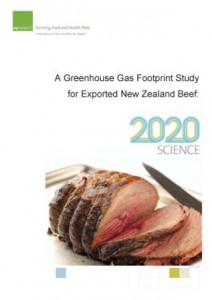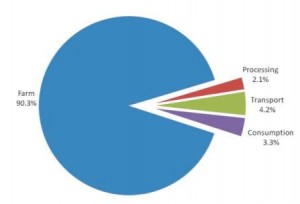Britain’s Daily Mail newspaper ran an article this week suggesting that (un-named) ‘experts’ were claiming British shops should sell New Zealand lamb because British farming methods produce twice as much greenhouse gas.
The item, which has been picked up and run in various New Zealand papers, was based around a newly released United Nations Consultative Group on International Agricultural Research (CGIAR) analysis Climate Change and Food Systems. Taking a closer look it’s clear that the comprehensive study itself didn’t actually say that but it was an interesting read, presenting for the first time the GHG footprint for the global food industry and showing that global agriculture is a much larger contributor to climate change than previously thought.
The analysis, which was recently published in the 2012 Annual Review of Environment and Resources presents figures showing that feeding the world released up to 17,000 megatonnes (Mt) of carbon dioxide into the atmosphere in 2008, contributing up to 29 percent of greenhouse gas (GHG) emissions. But while the emissions ‘footprint’ needs to be reduced, a companion policy brief by CGIAR’s research programme on climate change, agriculture and food security (CCAFS) – Recalibrating Food Production – lays out how climate change will require a complete calibration of where specific crops are grown and livestock raised.
Together, the two reports “shed new light on the intertwining evolutions of climate change and the world’s food system and their potential impact on humanity’s relationship with food,” says CGIAR.
Climate change mitigation and adaptation are critical priorities, according to Bruce Campbell, CCAFS’ programme director. “Farmers around the world, especially smallholder farmers in developing countries, need access to the latest science, more resources and advanced technology. This research services as an urgent call for negotiators at the upcoming UN Framework Convention on Climate Change in Doha.”
CGIAR Consortium chief executive Frank Rijsberman says: “We are coming to terms with the fact that agriculture is a critical player in climate change. Not only are emissions from agriculture much larger than previously estimated, but with weather records being set every month as regional climates adjust and reset, there is an urgent need for research that helps smallholder farmers adapt to the new normal.”
Climate Change and Food Systems assesses the entire food system’s emissions ‘footprint’ – in total somewhere between a fifth and a third of the greenhouse gases emitted by people on this planet. “This figure accounts for every aspect of food production and distribution – including growing crops and raising livestock, manufacturing fertiliser and storing, transporting and refrigerating food. Agriculture accounts for around 80 percent of these emissions, but the combined contribution of transport, refrigeration, consumer practices and waste management is growing,” according to CGIAR.
“The food-related emissions and, conversely, the impacts of climate change on agriculture and the food system, will profoundly alter the way we grow and produce food. This will affect different parts of the world in radically different ways, but all regions will have to change their current approach to what they grow and eat,” says Sonja Vermeulen, the head of research at CCAFS and the lead author of the study.
Delving deeper
Climate Change and Food Systems adds the figures across the aggregate global food chain, and assuming a growth in emissions of three percent a year, gives the total global greenhouse gas (GHG) emissions for 2008 in the range of 9,800 to 16,900 megatonnes of carbon dioxide equivalent (MtCO2e) from the food system, inclusive of indirect emissions associated with land-cover change. “Thus the food system contributes 19-29 percent of total global anthropogenic GHG emissions … Of this, agricultural production, contributes 80-86 percent at the global level, while the remainder comes from pre-production (predominantly fertiliser manufacture) and the post-production activities of processing, packaging, refrigeration, transport, retail, catering, domestic food management and waste disposal (landfills).”
Reflecting findings from New Zealand’s own 2010 GHG footprint for lamb, where 80 percent of emissions were also found to be from on-farm, the study notes that packaging for both vegetables and meat “is of minor importance in terms of total food emissions.” Transport “makes a large direct contribution” – for example, of the 19MtCO2e produced transporting food around Britain in 2002, 10Mt were emitted in the UK, all from road transport. An interesting estimate from a US researcher is that the same amount of fuel “can transport five kg of food only one km by car, 43 km by air, 740 km by truck, 2,400 km by rail and 3,800 by sea”. So, if that is correct, transporting the five kg of food 3.15 kms by car is the equivalent of a 12,000 km journey by sea, in terms of fuel used. For New Zealand lamb, transport accounts for five percent of the product footprint.
Refrigeration is noted to be the “major energy-intensive component of the food chain”. Limited data brought together by the study suggests that it accounts for one percent of total global GHG emissions and another researcher has estimated it accounts for 15 percent of electricity use worldwide. Food waste also contributes to GHG emissions directly through methane emissions from landfills and handling the waste to get it to landfill.
New Zealand: lead role
New Zealand has been taking a lead role on the world stage in tackling agricultural emissions. The Pastoral Greenhouse Gas Research Consortium (PGgRC), was established in 2002 and the New Zealand Agricultural Greenhouse Gas Research Centre (NZAGRC) opened in 2010. The latter recently released its highlights for 2012 detailing progress made in research focusing on mitigation of methane and nitrous oxide emissions, in understanding soil carbon and in developing integrated systems. The work on the GHG footprint for New Zealand beef was also recently released and will be covered in the forthcoming Food New Zealand magazine (December/January 2012) and included in this blog.
 Meat Industry Association (MIA) chief executive Tim Ritchie says that his organisation had supported the study because sustainability is still a critical issue in important markets.
“While it is possibly not as front-of-mind in markets as it was two or three years ago, sustainability remains very important and greenhouse gas emissions are a key component of sustainability.”
The study has created a benchmark for understanding where greenhouse gas (GHG) emissions are occurring across the beef supply chain, including production, processing, transportation and consumption.It has found that the majority (over 90 percent) of emissions occur on the farm. The footprint varies depending on the type of farm, the sex and age of the animals and whether or not animals from the dairy industry are used.
Overall, the weighted New Zealand average GHG emissions from beef animals from sheep and beef farms was 10.5kg CO2-equvalents (CO2-e) per kg of liveweight.Emissions arising from transport to market are extremely low.
Transport accounts for 4.2 percent of emissions, the report shows. In particular, oceanic shipping is very efficient and this study shows it contributes just 1.1-2.7 percent of the total carbon footprint.In addition, consumption accounts for 3.3 percent of emissions whi
Meat Industry Association (MIA) chief executive Tim Ritchie says that his organisation had supported the study because sustainability is still a critical issue in important markets.
“While it is possibly not as front-of-mind in markets as it was two or three years ago, sustainability remains very important and greenhouse gas emissions are a key component of sustainability.”
The study has created a benchmark for understanding where greenhouse gas (GHG) emissions are occurring across the beef supply chain, including production, processing, transportation and consumption.It has found that the majority (over 90 percent) of emissions occur on the farm. The footprint varies depending on the type of farm, the sex and age of the animals and whether or not animals from the dairy industry are used.
Overall, the weighted New Zealand average GHG emissions from beef animals from sheep and beef farms was 10.5kg CO2-equvalents (CO2-e) per kg of liveweight.Emissions arising from transport to market are extremely low.
Transport accounts for 4.2 percent of emissions, the report shows. In particular, oceanic shipping is very efficient and this study shows it contributes just 1.1-2.7 percent of the total carbon footprint.In addition, consumption accounts for 3.3 percent of emissions whi le just 2.1 percent comes from processing, which the report notes “is an area over which industry has direct control and where technologies are available to reduce emissions.”
Dr Stewart Ledgard, the lead author of the report says that until there is a globally-agreed methodology for ‘footprinting’ of meat products, it is hard to assess how New Zealand’s footprint compared to others. This study used the Life Cycle Assessment approach, which is consistent with the PAS2050 published standard for GHG footprinting.The beef study was undertaken by AgResearch and funded by the Meat Industry Association, Ballance Agri-Nutrients, Landcorp and the Ministry for Primary Industries greenhouse gas footprinting strategy. B+LNZ Ltd and individual meat processors provided data and information for the study. This adds to a study already completed on New Zealand lamb’s carbon footprint in 2010.
le just 2.1 percent comes from processing, which the report notes “is an area over which industry has direct control and where technologies are available to reduce emissions.”
Dr Stewart Ledgard, the lead author of the report says that until there is a globally-agreed methodology for ‘footprinting’ of meat products, it is hard to assess how New Zealand’s footprint compared to others. This study used the Life Cycle Assessment approach, which is consistent with the PAS2050 published standard for GHG footprinting.The beef study was undertaken by AgResearch and funded by the Meat Industry Association, Ballance Agri-Nutrients, Landcorp and the Ministry for Primary Industries greenhouse gas footprinting strategy. B+LNZ Ltd and individual meat processors provided data and information for the study. This adds to a study already completed on New Zealand lamb’s carbon footprint in 2010.
